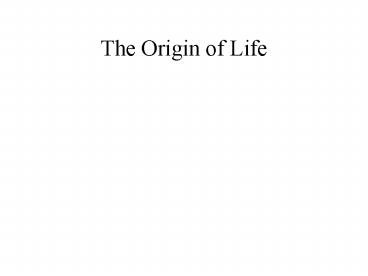The Origin of Life - PowerPoint PPT Presentation
1 / 17
Title: The Origin of Life
1
The Origin of Life
2
The earth and its atmosphere formed
- The primordial atmosphere originated from
outgassing of the molten interior of the planet (
through volcanoes ) and consisted of CO, CO2, H2,
N2, H2O, S, HCl and HCN, but little or no O2.
3
The primordial seas formed
- As the earth cooled, gases condensed to produce
primordial seas consisting of water and minerals.
4
Complex molecules were synthesized
- Energy Catalyzed the formation of organic
molecules from inorganic molecules. An organic
soup formed. - Energy was provided mostly by ultraviolet light
(UV), but also lightning, radioactivity and heat.
5
Complex molecules were synthesized (cont.)
- Complex molecules included acetic acid,
formaldehyde, and amino acids. These kinds of
molecules would later serve as monomers or unit
building blocks, for the synthesis of polymers.
6
Complex molecules were synthesized (cont)
- A. I. Oparin and J. B. S. Haldane independently
theorized that simple molecules were able to form
only because oxygen was absent. As a very
reactive molecule, oxygen, had it been present,
would have prevented the formation of organic
molecules by supplanting most reactants in
chemical reactions.
7
Complex molecules were synthesized (cont)
- Stanley Miller tested the theories of Oparin and
Haldane by simulating an experiment under
primordial conditions. He applied electric
sparks to simple gases (but no oxygen) connected
to a flask of heated water. After one week, the
water contained various organic molecules
including amino acids.
8
Polymers and self-replicating molecules were
synthesized.
- Monomers combines to form polymers. Some of
these reactions may have occurred by dehydration
condensation, in which polymers formed from
monomers by the removal of water molecules. - Proteinoids are abiotically produced
polypeptides. They can be experimentally
produced by allowing amino acids to dehydrate on
hot, dry substrates.
9
Organic molecules were concentrated and isolated
into protobionts.
- Protobionts were the precursors of cells. They
were able to carry out chemical reactions
enclosed within a border across which materials
can be exchanged, but were unable to reproduce. - Microspheres and coacervates are experimentally
and abiotically produced protobionts with
selective permeability.
10
Primitive heterotrophic prokaryotes formed
- Heterotrophs are living organisms that obtain
energy by consuming organic substances. - The organic soup was a source of organic
material for heterotrophic cells. As these cells
reproduced, competition for organic material
increased. Natural selection occurred.
11
Primitive autotrophic prokaryotes were formed
- As a result of mutation, a heterotroph gained the
ability to produce its own food. As an autotroph,
this cell would be highly successful. - Autotrophs manufacture their own organic
compounds using light energy or energy from
inorganic substances.
12
Oxygen and the ozone layer formed
- As a by-product of the photosynthetic activity of
autotrophs O2 was released and accumulated in the
atmosphere. - The interaction of UV light and O2 produced the
O3. - As a result the major source of energy for the
abiotic synthesis of organic molecules and
primitive cells was terminated.
13
Eukaryotes formedendosymbiotic theory
- According to the endosymbiotic theory, eukaryotic
cells originated from a mutually beneficial
association among various prokaryotes.
Specifically, mitochondria, chloroplasts, and
other organelles established residence inside
another prokaryote. Producing a eukaryote.
14
Evidence for endosymbiosis
- Mitochondria and chlorplasts resemble bacteria
and cyanobacteria with respect to their DNA, RNA
and protein synthesis machinery
15
Evidence for endosymbiosis
- Mitochondria and chloroplasts reproduce
independently of their eukaryotic host cell
16
Evidence for endosymbiosis
- Ribosomes of mitochondria and chlorplast resemble
those of bacteria and cyanobacteria, but differ
from those of eukaryotes.
17
Evidence for endosymbiosis
- The thylakoid membranes of chloroplasts resemble
the photosynthetic membranes of cynaobacteria.































